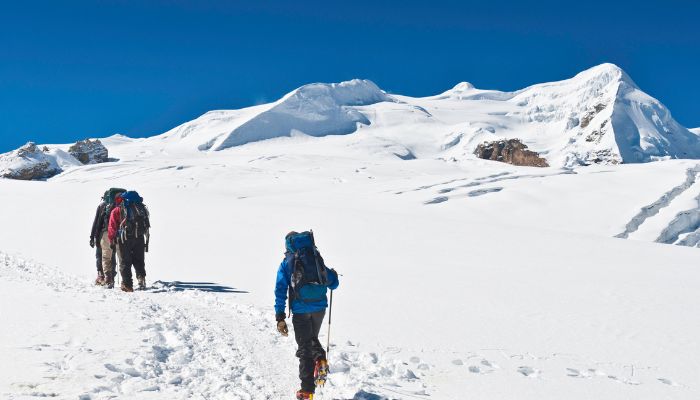
Mera Peak Climbing: Preparation, Routes, and Safety Tips

Mera Peak Climbing: Preparation, Routes, and Safety Tips
swotah travel
1890
16, 03 2023
Do you dare to venture on an adventure to the top of one of Nepal's tallest peaks? Mera Peak offers a breathtaking panoramic view of the majestic Himalayas, making it a highly sought-after destination for mountain enthusiasts. So, what's the Mera Peak climbing route like?
Beginning at Kathmandu, the route for Mera Peak climbing winds its way through various exciting terrains and environments, boasting multiple ascend and descent phases. It starts with a flight to Lukla, a small mountain town at 2,846 m/ 9,337 ft. Your trek begins with a magnificent adventure- beholding the spellbinding splendor of the Himalayas, indulging in the lush greenery of forests, and exploring the charming villages of Chutanga, Thuli Kharka, and Thaknak. So get ready for a once-in-a-lifetime memory.
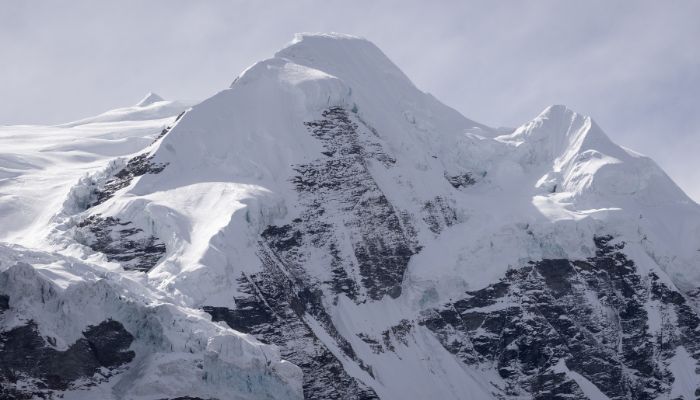
Photo: Mera Peak, the highest trekking peak in Nepal
Highlights of the Mera Peak
-
Cinematic view of mountain peaks like Mt. Everest, Makalu, Cho Oyu, Lhotse, and Kanchenjunga
-
Alluring Sunrise and Sunset views
-
Explore the Sherpa community and their culture
-
Delve into the taste of local cuisine
Overview of Mera Peak and the Surrounding Area
Mera Peak, Nepal's loftiest trekking peak, lures climbing newbies from far and wide to scale its heights in the legendary region where Mt Everest soars. A gleaming treasure of the Himalayas, in the northernmost Mahalangur range, has lured climbers since its accessibility. Mera Peak sparkles with three awe-inspiring summits: Mera Central (6,476m), Mera North (6,476m), and Mera South (6,065m), all awaiting their conqueror.
The trend of climbing Mera Peak, pre and post-Everest ascent, was started by Tenzing Norway Sherpa and Sir Edmund Hillary, the pioneers of Mount Everest's summit. Its allure only grows year after year, never lagging. Mera Peak is a stepping stone, a trial run for the grand Everest climb.
Nepal attracts thousands of climbing enthusiasts annually, with Mera Peak being their ultimate goal. Even Rookie climbers travel in droves, outnumbering the seasoned pros.
With its accessible climbing geography and technically-suitable setup, Mera Peak is the ideal destination for newbies on their mountaineering journey - the ultimate initiation to peak climbing.
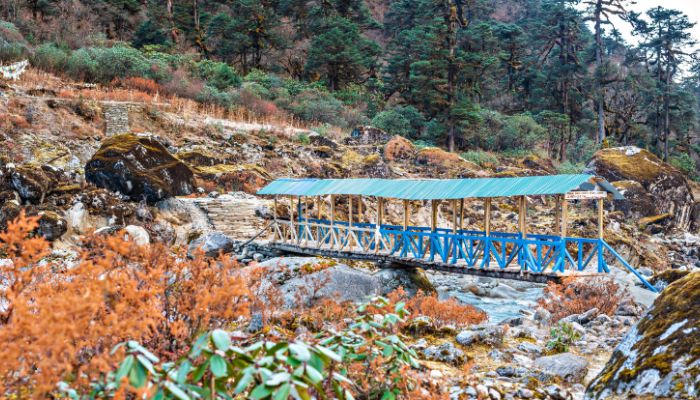
Photo: The wooden bridge in Khare on the trekking route to Mera Peak.
Climbing expeditions to Mera Peak boast multiple paths to choose from, tailored to your expertise and resources. Ascend via the challenging south ridge from Mera La, 5,400m/ 17,717 feet, or opt for the more forgiving direct route from Khare, 4,950m/ 16,240 feet. Be ready for a strenuous trek across glaciers and steep inclines regardless of the route.
The Khumbu valley, the birthplace of the majestic peak, weaves a mesmerizing route decorated with stunning streams and holy monasteries unique to the locale and its inhabitants. The Southern area encompasses the Tibet-bordering valley surrounded by the Khumbu's towering snowfields and glaciers, displaying awe-inspiring elevations and ice cliffs.
The Khumbu valley flaunts a wealth of wildlife species, featuring the renowned Himalayan Thar, Musk Deer, and Himalayan Tahr, amongst others. Spotting one of these during a Mera Peak trek elevates the experience to a more fulfilling and enjoyable one. From Mera Peak's summit, witness the awe-inspiring sight of four towering 8,000-meters: Everest (8,848m), Makalu (8,643m), Cho Oyu (8,201m), and Lhotse (8,586m). The Mera Peak trek passes through the legendary Khumbu region, with its distinct Sherpa villages, verdant forests, suspension bridges, historic gompas and monasteries, prayer flags, and more.
Mera Peak Climbing Routes
There are several routes to climb Mera Peak - for now, the North Face is considered the best and easiest route to the top of the peak. It is also the standard route most mountaineers use while attempting Mera Peak.
The North Face is said to offer the best experiences with its passing through the high altitude glacier. It is also considered best for safety as the snow conditions are mild.
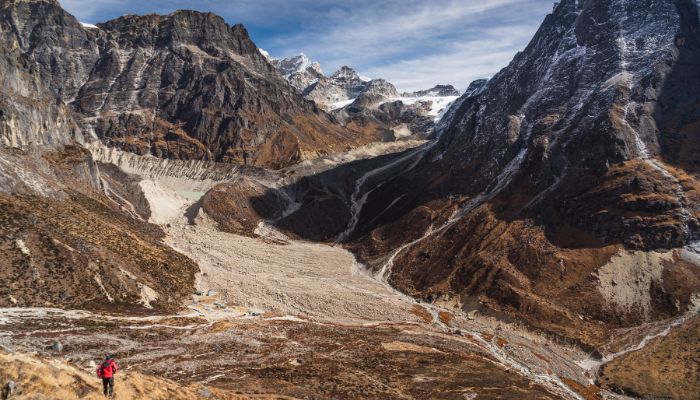
Photo:Top view of Thagnag village in Mera peak climbing route in Himalaya mountains range, Nepal.
Your Mera Peak journey starts from Lukla, where you will trek to Chhuthang and leave for Thuli Kharka. You will pass across the Zatra Wala Pass during the trek and stay overnight at Thuli Kharka. The next day early in the morning, you will set up your journey for Thangnak. You will hike through the lush forest with the rugged trail enjoying the scenic natural beauties.
The next destination will be Khare, which offers the sight of Mera Peak. You will stay overnight at Khare and acclimatize the next day before going to the Mera Peak Summit. From Khare, you will ascend towards the Mera Base Camp at 5300 meters and then head towards Mera High Camp at 5700 meters. With a rough climb over the High Camp, you will finally reach Mera Peak (6,476 Meters), and your summit is completed.

Photo: A Himalayan sheep grazing in the picturesque Mera Peak region.
After the successful climb, you must thoroughly descend back to High Camp and Mera Base Camp. Similarly, you will return to Khare, Kothe, and Thuli Kharka before reaching Lukla. You will catch a flight from Lukla to Kathmandu, which takes around 30 to 35 minutes.
Preparation And Safety Tips on Climbing Mera Peak
-
Physical Preparation:
Like other peaks, Mera Peak is also physically challenging. It would be best to have enough endurance and strength training, acclimatization, and practice hikes before taking on this expedition. Since Mera Peak stands at a towering height of 6,476 meters, you must be prepared for possible health hazards like altitude sickness and related illnesses.
-
Mental Preparation:
Being mentally strong to take on Mera Peak climbing is the most important thing here. You will need to accept and face any probable dangers and environment throughout your expedition. Before going on an expedition, research the route, understand the risks, and build confidence in your abilities.
-
Equipment and Gear Necessary:
Your Mera Peak climbing project does not end successfully without proper gear and equipment. You need to understand the harsh environment in the Himalayas and plan for the gear accordingly. When it comes to clothing, it is recommended to have thermal clothes, warm jackets, and others like socks, gloves, sunglasses, and many more. Besides that, you will also need glacier equipment like an ice axe, crampons, harnesses, and safety measures like a first-aid kit.
During the Climb
-
Acclimatization:
Acclimatization is an essential thing during any high-altitude treks. Your body will be tired and out of energy when you walk 8/9 hours a day at a high altitude; that's why you need to acclimate to adjust. Just take your time, and don't rush up the mountain. Also, take enough rest and stay hydrated.
-
Weather Considerations:
Weather can play an antagonist role during your mountaineering. That's why you should always be aware of the changing weather conditions and plan accordingly. Always listen to the weather forecast and prepare yourself for it. If the weather is bad, postpone your initial plans and search for alternatives. Heavy snowfall and storms are some factors you will face during your expedition.
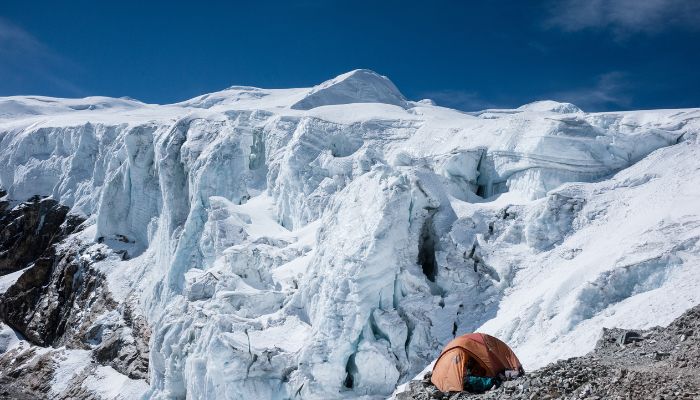
-
Route Planning:
Route planning comes under the significant planning section. You should always be familiar with the available routes and plan your itinerary accordingly. It's always better to know your way before setting off and have backup plans in case of bad weather or other unforeseen issues.
-
Nutrition and Hydration Tips:
Since we mentioned that Mera Peak climbing is physically demanding, being healthy and hydrated is the primary focus. You need to know that your body should be strong enough to take on the climb, and that is possible only if you are availed of the nutrients and enough food. Stay hydrated and eat regularly to keep energy levels up - it will be good for your health during climbing Mera Peak.
Emergency Situations
-
Altitude Sickness:
Altitude Sickness is one of the significant health hazards you will experience during your high-altitude treks. Mera Peak is over 6000 meters, so altitude sickness is not strange here. If you have had no exposure to high altitudes before or if you have other illnesses like asthma or respiratory problems, altitude sickness is more prone to you. You should always watch and learn for signs and symptoms of altitude sickness and be prepared to descend if necessary.
The most important thing is always to carry an oxygen cylinder with you since the air and oxygen levels at high altitudes are low and can lead to altitude sickness.
-
Injury:
Injuries are also the most common challenges you will face during peak climbing. Mera Peak also has some treacherous landscapes as it is steep and has numerous crevasses. You do not know what happens during the expedition, so always take the first aid kit with you, so it will be helpful in case you have any injuries.
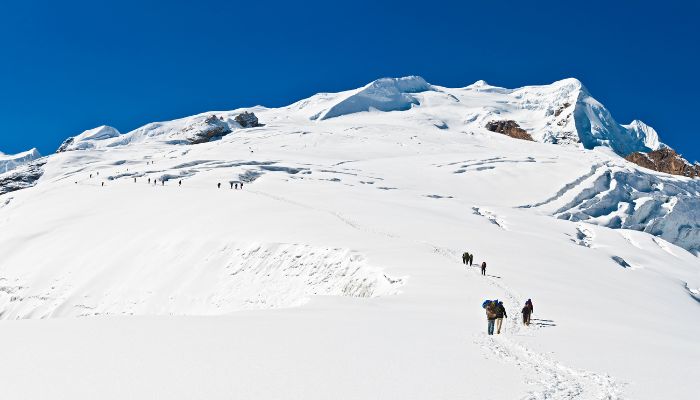
Photo: Climbers embarking on their journey to summit Mera Peak.
-
Getting Lost:
If you are climbing Mera Peak alone and need prior knowledge about the available routes, you are most likely to get lost. In that case, it's always good to hire porters and guides who can help you throughout your expedition. Also, always have an emergency GPS unit on hand to help you find your way back to safety if you become lost.
The Mera Peak route is generally challenging but worth it for mountain climbers. If you want to see the breathtaking views of the Himalayas, you need to be both physically fit and skilled in technical climbing. Although the climb can be challenging, it's a chance to discover the fascinating culture and gorgeous scenery of Nepal's Khumbu region. As long as you plan, get ready properly, and follow experienced guides, you can reach the summit of Mera Peak and come back home feeling accomplished and with a lifetime memory.
NEWSLETTER SIGNUP
Sign up to receive our trip ideas and travel offers!
Get updates and Exclusive Offers up to 20% Discount








